Ticks Suck
There are nearly 500,000 new cases of Lyme Disease in the U.S. each year. In addition to Lyme disease, ticks carry many other bacteria, viruses, and parasites.
Prevention and proper management of a tick bite can drastically reduce potentially severe illnesses.
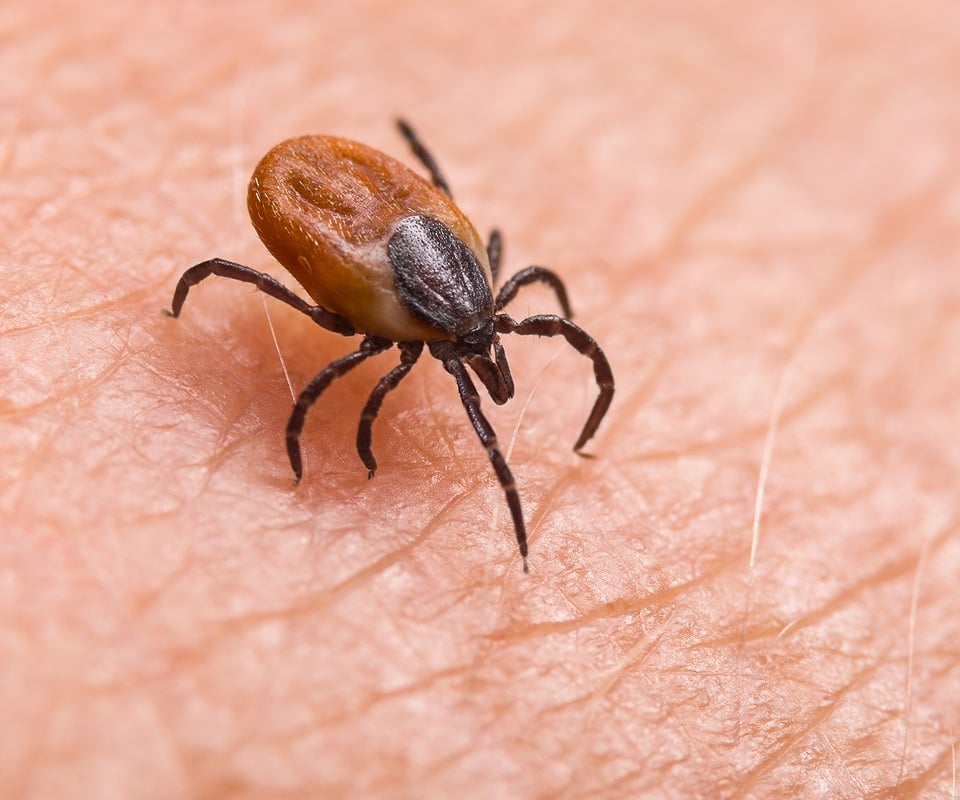

Ticks that cause Lyme disease and other infections are present in many parts of the world, in most states in the USA. According to the Center for Disease Control (CDC), these ticks have also been found in 56/58 of California counties.
High-risk activities include:
- Hiking
- Camping
- Golfing
- Mountain Biking
- Horseback Riding
Tick Bite Prevention
Understand where the ticks are. Ticks search for a meal or “quest” on the leaves and grasses. Stick to wider trails, stay towards the center of the trail, and avoid brushing through grasses.
Wear light colored clothes with long sleeve shirts, long pants, and tuck your pants into your socks.
You can use safe tick repellents like permethrin to treat clothing, tents, sleeping bags, picnic blankets, etc, to help lower the risk of a tick climbing onto your body. This chrysanthemum based product is safe for use and can be sprayed on, or you can also have your clothing professionally treated or purchase clothes that have been treated.
Other effective repellent products include:
- Lemon Eucalyptus Oil
- Nootkatone from Cypress trees and grapefruit
- Picaridin
- IR3535
- DEET containing products are also effective but are more toxic so we recommend using these more sparingly and for extreme exposure situations
When returning from being outdoors in tick endemic areas (which can also include city parks and lawns at home), change your clothes and put the used clothes in the dryer on high for at least 20 min. Shower and tick check carefully.
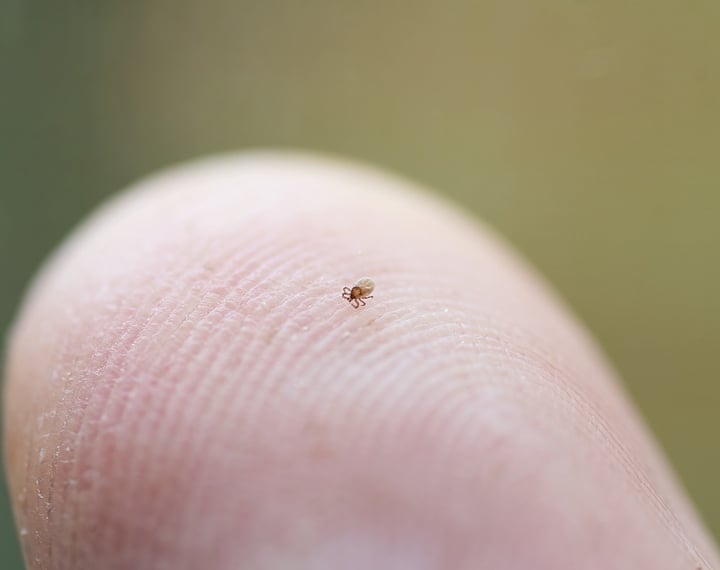

Tick Check
Check your children and partner thoroughly for ticks, and have someone check you, including behind the ears, under finger and toenails, belly button, groin, hairline, axilla, etc.
Check your children before bed nightly if they have been playing outside.
Nymph ticks are literally poppy seed-sized and frequently one cannot tell that it is a tick without a magnifying device. Your smartphone can be used as a magnifier which can be very helpful.
In California, the tiny nymph ticks are the highest risk for transmission of the Borrelia bacteria. The tiny size of this tick means that you have to be extra careful and thorough when performing tick checks in order to be safe.
It is also important to be careful with pets as vectors as they can bring ticks into the house.
Tick Removal Steps in Case of Bite
Once you have identified that a tick bite has occurred it is very important to understand proper tick removal technique.
Having the right tweezers on hand is critical. We recommend purchasing several of the TickEase tweezers to have at home, in your car, and in your backpack when hiking/camping. These are very well designed with an extremely fine tip specifically for tick removal.
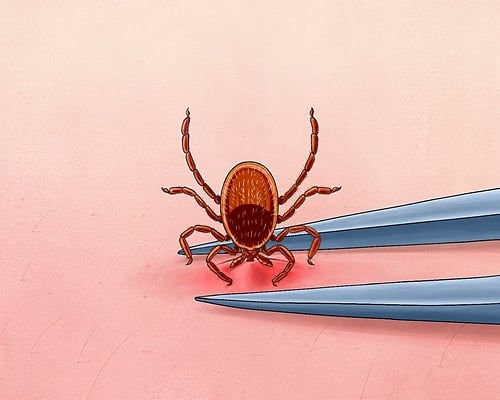
Insert the tweezers as close to the skin as possible and pinch off the mouth parts of the tick.
Step 1
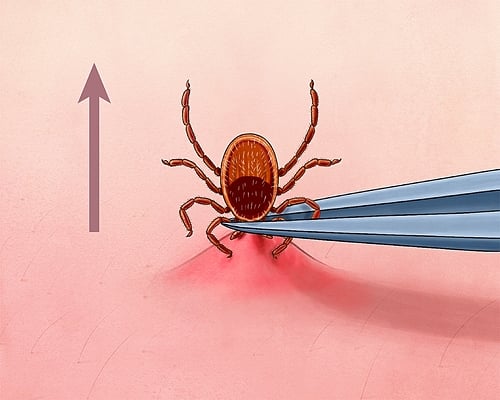
Gently lift perpendicular to where the tick is attached.
Step 2
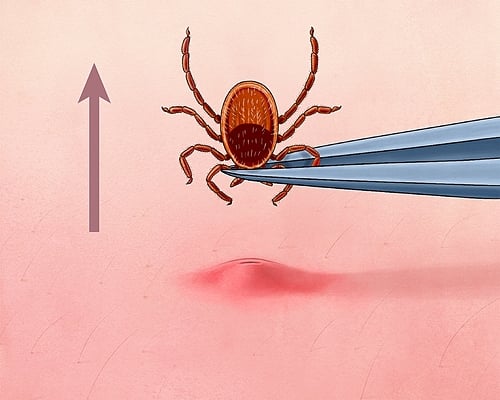
Provide traction and wait for the tick to release, this can take a few minutes if well attached.
Step 3
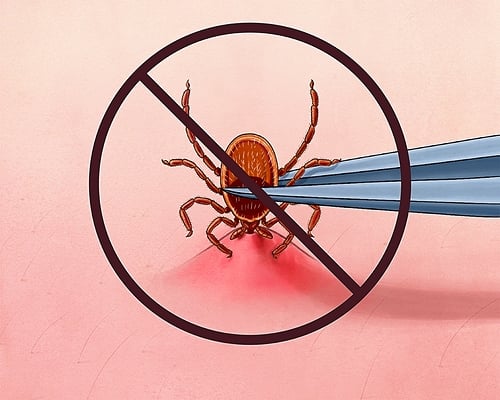
Do not squeeze the body, twist, burn, put on oil as this can increase the risk of infection as the tick might regurgitate its stomach contents into the bite area.
Important!

Once removed, place tick in a Ziploc bag with a moist paper towel. Try to identify the tick using Rhode Island Tick Encounter. Test the tick for pathogens with a service like TickReport.
Identify and test.
Knowing the type of tick can help your doctor know which pathogens might be present and help make decisions on whether or not to treat you while waiting for the results of the tick testing. Info on the type of tick can also be helpful if the tick was lost and not able to be tested.
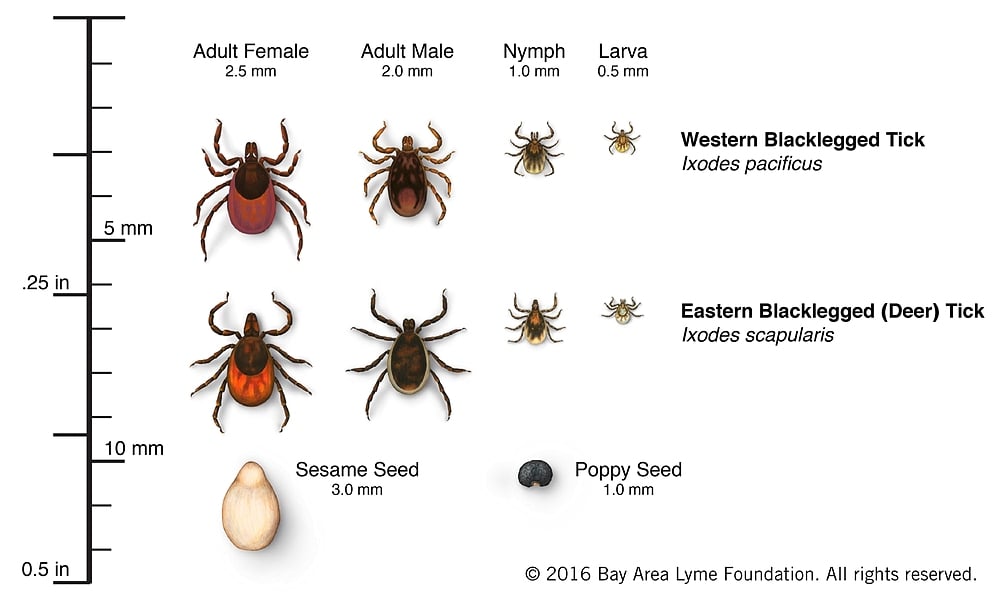
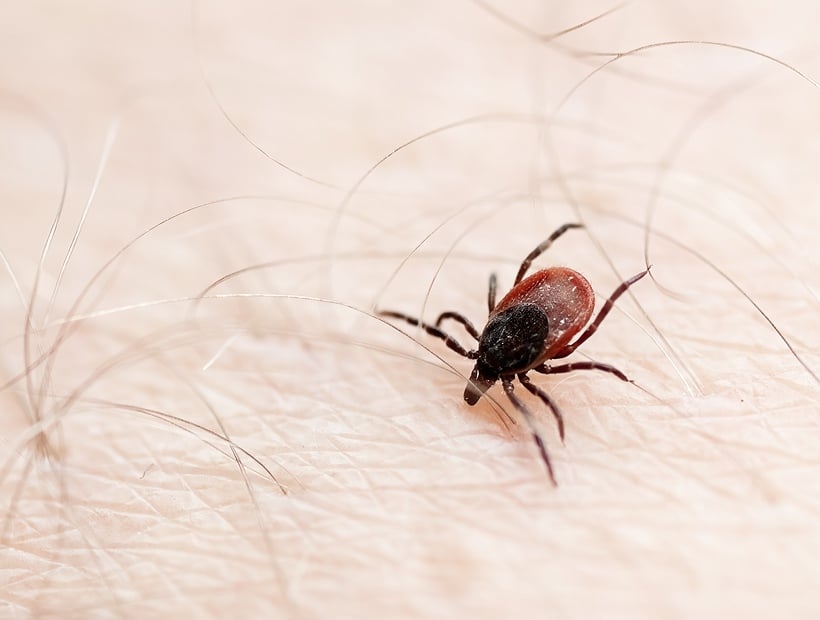
Tick Pathogen Testing
It is important to understand that sometimes tick identification will be easy based on the features present, and sometimes it will be very hard and require an expert to identify the tick.
Testing is particularly important with ticks that may transmit the Borrelia burgdorferi bacteria, as early treatment can make a big difference in outcomes and preventing chronic infection.
Tick Report is a comprehensive service run by the University of Massachusetts that identifies what disease causing microbes your tick may be carrying. They offer accurate reporting, basic and expanded panels of tests for different bugs, and the turnaround time is approximately 3 business days.
After a tick bite, watch for any unusual symptoms like skin rash, stiff neck, headache, muscle and/or joint pain, or flu-like symptoms. Consult a doctor knowledgeable in tickborne illnesses for proper diagnosis and treatment.
Lyme Disease FAQ
-
Lyme disease symptoms can vary depending on the stage of the infection, and coinfections can have their own unique symptoms.
Early Lyme (days to weeks after infection):
- Skin rash: Classically a bulls eye rash with central clearing, but can take many forms. Importantly, a rash appears less than half the time and is less common on the West coast
- Muscle and joint pain
- Headache
- Stiff neck
- Flu-like symptoms (including fever or chills)
- Fatigue or lack of energy
- Swollen lymph nodes
Disseminated Lyme (weeks to months after infection):
- Skin rashes
- Heart palpitations
- Dizziness and fainting
- Pain in arms and legs
- Numbness and tingling in arms and legs (this can come and go)
- Extreme joint pain (frequently with Lyme, the joint pain can migrate from joint to joint)
- Severe fatigue and lack of energy
- Difficulty with memory
- Unable to concentrate
- Headaches
- Facial nerve paralysis causing facial droop
Late stage Lyme (months to years after infection:
- Arthritis (can migrate from joint to joint or be in multiple joints)
- Nervous system problems such as numbness and tingling in hands, legs, feet, or back (can also come and go and move around the body)
- Stiff neck
- Severe headaches, or migraines
- Problems with memory
- Changes in hearing and vision
- Chronic severe fatigue
- Mood or sleep disorders
- Inflammation of heart or brain
-
Unfortunately, many tick bites go unnoticed. Ticks can be tiny, as small as a poppyseed or the period at the end of this sentence. Ticks also frequently bite us in places we cannot see such as behind (or in) our ears, in our hair, or in our belly button. In addition, ticks anesthetize us when they bite so we frequently do not feel the bite.
-
Lyme has been diagnosed in all 50 states in the USA, and the ticks that carry the Lyme bacteria have been found in 43/50 of US States. New studies funded by the Bay Area Lyme Foundation also show that ticks capable of carrying Lyme and other tickborne diseases were found in 83 counties (in 24 states) where these ticks had not been previously recorded.
Lyme disease is the fastest growing infectious bacterial disease in the USA, and the most common vector borne disease in the USA.
Lyme and tickborne diseases are also common in many places in the world, especially North America, Europe, and Asia.
-
Many sources say that a tick has to be attached for 24-48 hours in order to transmit Lyme. While there certainly is increased risk of getting an infection with longer duration attachment, in some cases transmission can occur much more quickly. In addition, other bacteria and parasites that the tick may be carrying can be passed with a much shorter duration tick bite. Any high risk tick bite needs to be treated seriously, regardless of how long the tick was attached.
-
This is not true. Lyme disease and other tickborne pathogens are absolutely present in California.
According to the California Department of Public Health, Western black-legged ticks (Ixodes pacificus) that carry Lyme and other pathogens have been found in 56/58 of counties in California.
The Borrelia burgdorferi (Lyme) bacteria has been found in these ticks in 42/58 of these counties.
Rates of tick infection with Lyme vary geographically, and by the life stage of tick. Nymphs (poppy seed sized) are the highest risk. In hotspot areas like Mendocino county, studies have documented that up to 41% of the nymph ticks tested were positive for Lyme.
-
Unfortunately, the tests for Lyme disease and other tickborne infections are not very accurate. Particularly early in the illness, the tests can miss more than half of cases. Later in the illness, your immune system can struggle to make antibodies to the infections, and tests can also be falsely negative. Furthermore, there are many strains of the Lyme bacteria, and other newly identified pathogens like Borrelia miyamotoi, that the traditional tests do not test for. There are many different testing methods and companies that can be used, and it is necessary to carefully consider any test data in combination with your symptoms and unique case.
-
If you are struggling with a complex, multisystem illness, and doctors are not finding answers or treatments to get you better, it is important that you work with a team that understands tickborne diseases. Not every tick bite causes infection, but if you have ever been in a Lyme endemic area of the world, and you have ongoing health issues, it is possible that an underlying infection is contributing. A deep investigation for Lyme, coinfections, and other pathogens may provide new information and direction for your recovery.
-
Lyme disease is caused by the spirochete bacteria Borrelia burgdorferi, which is related to Syphilis. Similar to its cousin Syphilis, Lyme is known as “The Great Masquerader” and can cause health issues across many different body systems. Lyme and tickborne coinfections can mimic, contribute to, trigger, or be misdiagnosed for conditions such as:
- Chronic Fatigue Syndrome
- Fibromyalgia
- MS
- Parkinson’s
- ALS
- Alzheimer’s
- Rheumatoid Arthritis
- Lupus
- Atypical anxiety
- Depression, and many more.
-
Ticks are known as “nature’s dirty needle.” In addition to Borrelia burgdorferi (Lyme), ticks can pass a number of different pathogens such as:
- Babesia
- Bartonella
- Anaplasmosis
- Ehrlichiosis
- Borrelia Miyamotoi
- Rocky Mountain Spotted Fever
- Borrelia Mayonii
- Colorado Tick Fever
- Heartland Virus
- Powassan Virus
- Q Fever
- Relapsing Fever
- Southern Tick-Associated Rash Illness
- Tickborne Encephalitis
- Tularemia
In addition, ticks can cause non infectious issues such as:
- Tick paralysis
- Alpha-Gal meat allergy
-
A rash after a tick bite can have multiple causes, ranging from mild skin irritation to serious infections. Here are the main possibilities:
1. Localized Reactions
-
If you develop a rash within minutes to hours after a tick bite, it is likely that is caused by a localized reaction. Most of the time you can just monitor this. It is a good idea to mark the border with a sharpie to see if the rash continues to expand, and get help if it does and/or if you have any other worrisome symptoms. The two most common reasons for a localized reaction are:
-
Irritation from the bite – Redness, swelling, or itching at the bite site due to minor trauma or saliva proteins.
- Allergic reaction – Some people develop a hypersensitivity reaction to tick saliva, leading to redness, itching, or swelling.
-
2. Tickborne Infections
-
Lyme Disease (Borrelia burgdorferi)
-
Erythema Migrans (EM) – Expanding, ring-like rash (can appear 3-30 days post-bite). EM is classically a bulls eye rash with central clearing, but can take many forms. Importantly, a rash appears less than half the time and is less common on the West coast
-
-
Southern Tick-Associated Rash Illness (STARI)
-
Similar to Lyme disease rash but without a positive Lyme test; caused by Amblyomma americanum (Lone Star tick).
-
-
Rocky Mountain Spotted Fever (Rickettsia rickettsii)
-
Red or purplish rash that starts on wrists, ankles, or palms/soles and spreads (appears 2-5 days after fever starts).
-
-
Ehrlichiosis & Anaplasmosis
-
Sometimes associated with a maculopapular or petechial rash.
-
-
Tularemia (Francisella tularensis)
-
Ulcer at the bite site, accompanied by swollen lymph nodes.
-
-
Babesiosis
-
Rash is rare but possible in some cases.
-
-
Bartonella (Cat Scratch Fever, Trench Fever)
-
Can cause various skin rashes, streaks, or nodules.
-
3. Secondary Infections
-
Cellulitis – Bacterial infection (e.g., Staphylococcus or Streptococcus) from scratching or improper tick removal.
-
Abscess Formation – Pus-filled lesion if bacteria enter the wound.
4. Autoimmune & Delayed Hypersensitivity
-
Alpha-Gal Syndrome (Mammalian Meat Allergy)
-
Can cause hives, itching, or anaphylaxis after eating red meat (triggered by Amblyomma americanum tick bite).
-
-
Serum Sickness-Like Reaction
-
Rash, fever, joint pain occurring days to weeks after a tick-borne infection.
-
5. Other Causes
-
Coincidental Dermatologic Condition – Eczema, contact dermatitis, fungal infections, or other pre-existing skin issues.
Bottom line, if you had a tick bite and you develop a rash, you should be seen by a medical provider knowledgeable in the nuances of tickborne diseases. If you need help, reach out. We have a special Lyme prevention program to help people recover from tick bites and prevent long-term health issue.
-

